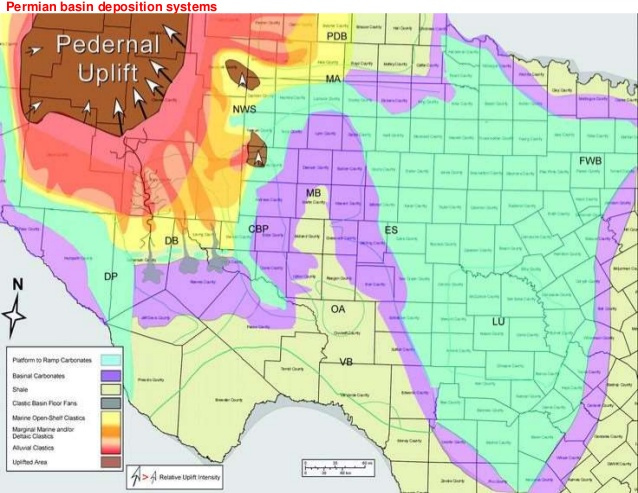Nuclear magnetic resonance used to characterize oil and gas shale formations
Nuclear magnetic resonance used to characterize oil and gas shale formations
Researchers at Rice University have used nuclear magnetic resonance (NMR) tools to characterize methane over a wide range of densities and temperatures spanning the liquid state to the gas state.Read More
/////////////////////////////////////////////////////////////////////////////////////////////// Expect much more use of NMR in the Delaware Basin for exploration and pinpointing resources, both oil/gas/liquids and metals…gold, silver, beryllium, lithium hydrides, etc. More scientific exploration of the area is coming.
'…[0005] In the field of petroleum, NMR has been applied mainly to techniques for down hole logging of oil wells in view of determining properties of live oil and wettability of oil formations after drilling, both by processes involving extraction of fluids from bore holes, and generating pulses from bore holes measured with antennae after the expense of drilling, dismissing the predictive powers of other crude specimens at the locations or in the drilled field. [0006] No proponent has ever advanced a body of theory or methodology by which to detect oil or gas from the surface by NMR in view of drilling to a predicted target, nor to exercise mobility to examine remaining reservoir qualities from the surface by NMR, nor to identify, determine depths, or map faults in a given area by NMR, nor to use NMR as a tool to condemn non-bearing hydrocarbon areas. SUMMARY OF THE INVENTION [0007] The present invention provides a method for detecting subterranean reservoirs of oil and/or gas comprising the steps of obtaining a specimen of oil having a known composition of elements and compounds; providing a standardized NMR apparatus having a standardized cell; introducing a molecular amount of said specimen in said standardized cell; orienting the standardized cell proximal and perpendicular to the earth; scanning at or near the surface of the earth with said standardized cell containing said specimen until said standardized cell precesses; assigning test values upon which to evaluate the precession of the standardized cell; and determining the presence or absence of oil in the ground based on said assigned test values and the precession of the standardized cell…"
This seems reminiscent of applied kinesiology muscle testing for allergies; dowsing; divination; etc.
Not so. Nothing mystical about NMR. Every atom of every
molecule has a resonant frequency. The molecule will absorb
energy at all other frequencies but its Resonant frequency.
When strobed with a resonant frequency that is resonant with
the molecule you are searching for, the resonant reflected wave will literally ‘light up’ the molecules like a blip on a radar
screen. All you have to do then is program your signals processor computer to assign a specific color to the desired
molecules on the computer display. Then strobing, or pulsing
an area under the transmitting antenna array on the surface
will light up the desired metals, minerals, or anything you want to program the computer to look for and flag for your
perusal at all depths to the limit of the NMR probe signal.
Adjustable aperture resonant antennas supply the directed signal into the Earth so the receiver is off during transmission, then listening when the transmitter is off. This is done in nanosecond intervals (billionths of a second).
So…you get a 3d color display real time of the desired mineral, metal, etc that you are looking for and pinpoints the depth and direction the minerals are going relative to a fixed point on the surface, courtesy of the signals processing computer.
Incidentally, my degree is in Electrical Engineering, Applied Electronics.
Additionally, 85 to 95 percent of all natural gas is METHANE… NH4…one nitrogen atom, 4 hydrogen atoms per molecule. So that’s why they are running an NMR resonant signal survey using the resonant frequency of Methane. This tells them the size of the reservoir of natural gas, how densely packed the gas molecules are which tells them what the bottom hole pressure of any bore into that area will produce.
Similarly, by choosing the molecule and its resonant frequency, they can choose to define crude oil depositions at any depth…choose another molecular resonant frequency for NGLs…natural gas liquids to see how ‘wet’ the gas from the highlighted area will be. That enables them to concentrate on areas with high percentage of wet gas, or high volume crude oil.
The wildcatting guesswork of oil and gas exploration is coming to an end…replaced by applied technology.
I was implying there may be something there there with the other methods, not that NMR is mystical. Why molecules have a resonant frequency in the first place of course takes one into the mystical, but that is outside my interest as it relates to this discussion and the scope of this forum. Is surface NMR in use today, or is surface NMR needing technological improvements. Other than the linked patent, I have only heard of downhole NMR with regard to oil and gas.
